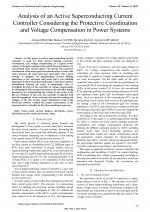| 4/2020 - 4 |
Analysis of an Active Superconducting Current Controller Considering the Protective Coordination and Voltage Compensation in Power SystemsGHAFARI, A. |
| Extra paper information in |
| Click to see author's profile in |
| Download PDF |
Author keywords
fault current limiters, microgrids, power distribution, power system protection, relays
References keywords
current(27), fault(16), supercond(14), tasc(12), superconducting(10), limiter(10), active(9), power(8), coordination(8), type(6)
Blue keywords are present in both the references section and the paper title.
About this article
Date of Publication: 2020-11-30
Volume 20, Issue 4, Year 2020, On page(s): 29 - 36
ISSN: 1582-7445, e-ISSN: 1844-7600
Digital Object Identifier: 10.4316/AECE.2020.04004
Web of Science Accession Number: 000594393400004
SCOPUS ID: 85098132932
Abstract
In this paper, an active superconducting current controller is used for fault current limiting, protective coordination, and voltage compensating in a typical power system. In the grid-connected micro-grid, the performance of a conventional fault current limiter can disrupt the protective coordination of the micro-grid overcurrent relays as well as the relays between the main grid and micro-grid. The control strategy is designed for implementing normal limiting impedance in the upstream fault mode and a zero limiting impedance in the downstream fault mode so that the protective coordination between all relays is maintained. Also, to investigate the effect of the controller on voltage compensating, by obtaining the line transmission matrix, the controller setting parameters for compensating the voltage at any point of the line are obtained. In this case, the controller is adjusted such that the magnitude of the receiving end and the sending end voltages of the line become equal. Simulation results using MATLAB software confirm the proper performance of the proposed active controller for the above-mentioned purposes. |
| References | | | Cited By |
Web of Science® Times Cited: 0
View record in Web of Science® [View]
View Related Records® [View]
Updated 3 weeks, 6 days ago
SCOPUS® Times Cited: 0
View record in SCOPUS® [Free preview]
There are no citing papers in the CrossRef Cited-by Linking system.
Disclaimer: All information displayed above was retrieved by using remote connections to respective databases. For the best user experience, we update all data by using background processes, and use caches in order to reduce the load on the servers we retrieve the information from. As we have no control on the availability of the database servers and sometimes the Internet connectivity may be affected, we do not guarantee the information is correct or complete. For the most accurate data, please always consult the database sites directly. Some external links require authentication or an institutional subscription.
Web of Science® is a registered trademark of Clarivate Analytics, Scopus® is a registered trademark of Elsevier B.V., other product names, company names, brand names, trademarks and logos are the property of their respective owners.
Faculty of Electrical Engineering and Computer Science
Stefan cel Mare University of Suceava, Romania
All rights reserved: Advances in Electrical and Computer Engineering is a registered trademark of the Stefan cel Mare University of Suceava. No part of this publication may be reproduced, stored in a retrieval system, photocopied, recorded or archived, without the written permission from the Editor. When authors submit their papers for publication, they agree that the copyright for their article be transferred to the Faculty of Electrical Engineering and Computer Science, Stefan cel Mare University of Suceava, Romania, if and only if the articles are accepted for publication. The copyright covers the exclusive rights to reproduce and distribute the article, including reprints and translations.
Permission for other use: The copyright owner's consent does not extend to copying for general distribution, for promotion, for creating new works, or for resale. Specific written permission must be obtained from the Editor for such copying. Direct linking to files hosted on this website is strictly prohibited.
Disclaimer: Whilst every effort is made by the publishers and editorial board to see that no inaccurate or misleading data, opinions or statements appear in this journal, they wish to make it clear that all information and opinions formulated in the articles, as well as linguistic accuracy, are the sole responsibility of the author.



